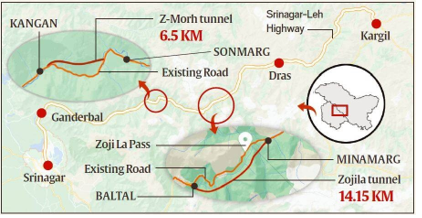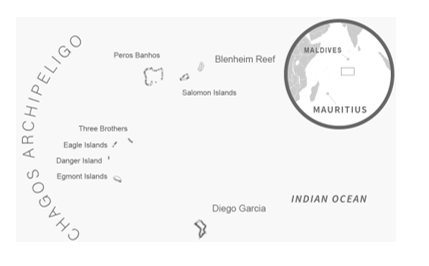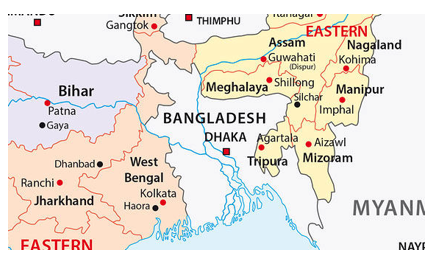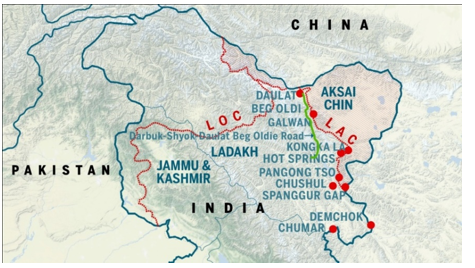

14th January 2025 (13 Topics)
Mains Issues
Context
The recent incident in Dima Hasao district of Assam, where several workers were trapped due to flooding in a rat-hole mine, highlights the ongoing dangers of this unregulated mining practice.
What is Rat-Hole Mining?
- Rat-hole mining is a method of coal extraction commonly used in the narrow, horizontal coal seams of Northeast India, particularly in Meghalaya.
- It involves digging narrow pits or tunnels, referred to as "rat holes," that are just large enough for one person to enter. Workers descend into these pits using ropes or bamboo ladders to extract coal manually with basic tools like pickaxes and shovels.
- There are two main types of rat-hole mining:
- Side-Cutting: Narrow tunnels are dug on hill slopes until a coal seam is found, typically less than 2 meters thick.
- Box-Cutting: A rectangular opening is created, and a vertical pit is dug up to 400 feet deep, with horizontal tunnels cut for coal extraction.
- The National Green Tribunal (NGT) banned rat-hole mining in 2014 due to its severe environmental and safety risks. The ban was upheld in 2015 after reports of fatal accidents, particularly during the rainy season when mines were prone to flooding.
- Despite the ban, illegal rat-hole mining persists, especially in areas like Meghalaya, due to a lack of viable alternative livelihoods for the local communities.
Safety and Environmental Concerns:
- Safety Hazards: The mining process is dangerous due to the lack of proper ventilation, structural support, and safety measures. There have been numerous accidents and fatalities, especially when tunnels collapse or are flooded.
- Environmental Impact: Rat-hole mining leads to land degradation, deforestation, and water pollution, as the process disturbs large areas of the landscape without proper waste management.


Mains Issues
Context
The Genome India Project aims to create a detailed map of the genetic diversity of India by sequencing the genomes of individuals from across the country. Recently, the Department of Biotechnology launched a new platform to share the data of 10,000 human genomes, which includes healthy individuals from 99 ethnic groups. This dataset will help researchers understand India’s unique genetic makeup, and future plans include sequencing up to 1 million genomes.
What is Genome Sequencing?
- The human genome is the complete set of genetic information that decides how our body functions and develops.
- It contains instructions for everything from our height and eye color to diseases we may inherit or are prone to.
- Genome sequencing is the process of reading and decoding the genetic material (DNA) from a sample, usually blood.
- The DNA is cut into smaller pieces, and each piece is sequenced. These pieces are then put together to form a complete genome, much like assembling a jigsaw puzzle.
What is the Genome India Project?
- India has over 4,600 distinct populations, and the Genome India project was started to capture this genetic diversity at a national level.
- The project began in 2020, and 20 scientific institutions have worked together to sequence the first 10,000 genomes. The project is aimed at creating a resource that can help in understanding how genes impact diseases, health, and medicine.
- This initiative is an effort to create a baseline genetic map that reflects India's unique genetic makeup, unlike global databases.
Why is this Project Important?
- Disease Prevention and Treatment: Understanding genetic factors that contribute to diseases can help create targeted treatments and diagnostic tests. For example, certain gene therapies can be developed to modify, delete, or add genes to treat diseases, which requires a genetic map like this.
- Identifying Unique Genetic Variants: The project has already identified 135 million genetic variations, of which 7 million are unique to India and not found in global databases. This helps in understanding diseases specific to Indian populations.
- Understanding Disease Prevalence: Population-level sequencing can reveal how common certain genetic mutations are in India. For example:
- MYBPC3 mutation: Linked to early heart failure, found in 5% of Indians, but rare globally.
- LAMB3 mutation: Causes a lethal skin condition, found in 4% of people near Madurai, but not seen globally.
- Identifying Rare Diseases: The project can help identify rare diseases found in specific Indian populations, enabling the development of gene therapies to treat them.
- Drug Resistance: It may help identify genetic variations that make some people resistant to certain medicines, like anaesthetics. For example, a group in South India lacks a gene to process common anaesthetics, which can lead to severe reactions or even death.
Global Context
- This project is part of a global effort to map human genomes. For example:
- The Human Genome Project (2003) mapped the first human genome.
- The 1,000 Genomes Project (2012) sequenced genomes of 1,092 people.
- The UK Biobank sequenced 100,000 genomes by 2018.
- Europe’s Million Genomes project aims to sequence 1 million genomes across 24 countries.


Prelims Articles
Context
Prime Minister Narendra Modi recently inaugurated the Z-Morh Tunnel in Ganderbal’s Sonamarg area, located in Jammu and Kashmir.
About the Tunnel:
- The Z-Morh Tunnel is located in the Ganderbal district of Jammu and Kashmir, India. It starts from Gagangir and its ending point is Sonamarg.
- The Tunnel is designed to ensure all-weather connectivity between Gagangir and Sonamarg, two important locations in the region that were previously inaccessible during heavy snowfall.
- This Z-Morh tunnel is part of the larger NH1 Srinagar-Leh Highway network.
- This will make Sonamarg a year-round tourist destination.
Key Features of the Z-Morh Tunnel:
- Length and Structure:
- The tunnel itself is 6.5 kilometers long.
- It is a bi-directional tunnel, meaning vehicles can travel in both directions.
- In addition to the main tunnel, there are 6.05 km of approach roads leading to both ends of the tunnel.
- The tunnel is situated at a height of approximately 2,637 meters (8,652 feet) above sea level.
- Capacity and Usage: The tunnel is designed to handle up to 1,000 vehicles per hour with a speed limit of 80 km/hr.
- It includes a 7.5-meter-wide emergency escape tunnel for safety, which also has potential future use for railway access.
- Developed with the New Austrian Tunneling Method (NATM), the tunnel is known for its efficiency in tunnelling through challenging geological conditions.
- Engineering and Construction: The tunnel was constructed using the New Austrian Tunneling Method (NATM), a technique known for its efficiency in challenging geological conditions.
- The tunnel took nine years to build, with construction starting in May 2015 and completion in 2024. The total cost of construction was Rs 2,700 crore.
Strategic Importance:
- Safety and Travel Efficiency: The Z-Morh Tunnel replaces a Z-shaped stretch of road that was prone to avalanches and landslides, significantly improving the safety and efficiency of travel.
- Military and Civil Use: In addition to civilian use, the tunnel is also strategically important for military logistics in the region.
- Tourism and Connectivity: The Z-Morh Tunnel will help reduce travel time between Srinagar and Sonamarg, making the area more accessible year-round for both locals and tourists.
- When completed, the Zojila Tunnel (another key tunnel) will further enhance connectivity between Srinagar and Ladakh.


Prelims Articles
Context
The British Navy detained the fishermen while they were fishing for tuna near Diego Garcia. The fishermen were reportedly arrested for allegedly crossing the International Maritime Boundary Line (IMBL).
About Diego Garcia:
- Diego Garcia is part of the Chagos Archipelago, a group of islands in the British Indian Ocean Territory (BIOT).
- It is a tropical, footprint-shaped, coral atoll located seven degrees south of the equator.
- It became a British colony in 1814 following the Napoleonic Wars.
- The UK separated the Chagos Archipelago from Mauritius in 1965 to establish the BIOT, making it one of the last British colonies.
- Diego Garcia is a military base that houses S. Navy and Air Force personnel who carry out operations from the island.
- The island is situated about 1,796 km south of India and 4,723 km east of Africa.
- Originally, the island was inhabited by the Chagossians (Ilois), descendants of African and Indian laborers, but they were removed in the 1960s to make way for the military base.


Prelims Articles
Context
A strong earthquake recently struck the Kyushu region in southwestern Japan. The earthquake had a preliminary magnitude of 6.9 and occurred at a depth of 30 km.
Why Japan Faces Earthquakes?
- Japan lies along the Ring of Fire, a region known for frequent earthquakes and volcanoes.
- This area includes several countries around the Pacific Ocean, such as the USA, Indonesia, Mexico, Japan, and others.
- The Ring of Fire is about 40,250 km long.
What is the Ring of Fire?
- The Ring of Fire is a zone around the Pacific Ocean where many tectonic plates meet.
- It is home to hundreds of volcanoes and earthquake sites.
- The region’s seismic activity is caused by interactions between tectonic plates, which are huge pieces of the Earth's crust that are constantly moving.
- Why Does the Ring of Fire Experience Earthquakes? Earthquakes happen when tectonic plates slide past, collide with, or move beneath each other. The edges of these plates can get stuck due to their rough surfaces, and earthquakes occur when they finally unstick.
In Japan, four tectonic plates are involved in these movements: the Pacific Plate, Philippine Sea Plate, Okhotsk Plate, and Eurasian Plate.
Why Are There So Many Volcanoes in the Ring of Fire?
- Volcanoes in the Ring of Fire form because of a process called subduction.
- The Ring of Fire is home to the world’s most active subduction zones, where this process occurs.
- This happens when one tectonic plate (usually an oceanic plate) slides beneath another plate, causing it to melt and form magma.
- The magma rises through the Earth's surface, creating volcanoes.


Prelims Articles
Context
January 12 is the birth anniversary of Swami Vivekananda, the famous Hindu spiritual leader and intellectual from the late 19th century.
About Swami Vivekananda
- Swami Vivekananda was born on January 12, 1863, in Kolkata as Narendranath Datta into a Bengali Kayastha family.
- From an early age, he was drawn to spirituality and philosophy. He was particularly interested in Western philosophy, history, and theology.
- Swami Vivekananda passed away on July 4, 1902, at the age of 39.
- Before his death, he wrote to a Western follower: “I shall inspire men everywhere until the whole world shall know that it is one with God.”
- Vivekananda is remembered as a patriotic saint, a key figure in the revival of Hinduism and Indian nationalism.
- His birthday, January 12, is celebrated as National Youth Day in India, to inspire the youth with his ideals and teachings.
- He was regarded by Netaji Subhas Chandra Bose as the “maker of modern India”.
Key Transformation
- He met Ramakrishna Paramahamsa, a mystic and spiritual leader, who became his guru. Vivekananda remained devoted to Ramakrishna until his guru’s death in 1886. After the death of Ramakrishna, Vivekananda traveled across India, spreading spiritual teachings and working to uplift the socio-economic conditions of the masses.
- In 1893, he took the name Vivekananda (after a request by Maharaja Ajit Singh of Khetri), changing it from his earlier name,
Chicago Address (1893)
- Vivekananda is globally recognized for his speech at the Parliament of the World’s Religions in Chicago in 1893.
- His address began with the famous words: "Sisters and brothers of America", and earned him a standing ovation.
- He spoke about universal acceptance, religious tolerance, and the unity of all religions, which he believed were different paths to the same spiritual truth.
- Key quotes from his speech:
- "I am proud to belong to a religion which has taught the world both tolerance and universal acceptance."
- "We accept all religions as true."
- "Sectarianism, bigotry, and its horrible descendant, fanaticism, have long possessed this beautiful earth."
- His speech presented Indian spiritual traditions as being superior in terms of tolerance and universal acceptance.
Return to India
- After his time in the West, Vivekananda returned to India and, in 1897, founded the Ramakrishna Mission to bring noble ideas to the poorest and most downtrodden people of India.
- He also established Belur Math in 1899 in Howrah, West Bengal, which became his permanent abode and the center of his mission.
Legacy and Teachings
- Vivekananda propagated the concept of 'Neo-Vedanta', an interpretation of Hinduism that was suited to the modern world, combining spiritual wisdom with material progress.
- He emphasized the practice of Yoga as a means of personal transformation and connection with the divine.
- Some of his most popular books include:
- Raja Yoga
- Jnana Yoga
- Karma Yoga
- He worked to spread awareness about Indian spiritual practices, particularly Yoga, in the West.
- He inspired millions through his writings and speeches, emphasizing that every soul is divine and that the goal of life is to realize and manifest this divinity.


Prelims Articles
Context
The Border Security Force (BSF) of India has been working on fencing India-Bangladesh border to prevent cross-border movement and security concerns. However, this initiative has recently led to objections from Bangladesh's interim government, which is reviewing past border agreements with India.
India-Bangladesh Border
- India and Bangladesh share the 4,096-kilometre-long border of which a 2,216.7 km border area is in West Bengal of this around 20 per cent stretch is unfenced.
- West Bengal, Assam, Meghalaya, Tripura and Mizoram are the States which share the border with Bangladesh.
Key Agreements:
Several important agreements have been made between India and Bangladesh over the years to address border issues. These agreements have focused on resolving land disputes, improving border security cooperation, and setting guidelines for infrastructure development near the border.
- 1974 Land Boundary Agreement: This agreement was crucial in resolving issues related to land exchange and the disposal of enclaves, which involved swapping territories between the two countries. It was a major step in resolving long-standing border disputes.
- The Tin Bigha Corridor, which provides Bangladesh access to a small piece of land, has also been a point of contention. Under the 1974 agreement, Bangladesh ceded some territory to India in exchange for this corridor access. However, disputes have arisen over India's commitment to keeping this corridor open, especially with new agreements allowing fencing near it.
- 1975 Joint Indo-Bangladesh Guidelines for Border Authorities: This agreement set the groundwork for cooperation between India and Bangladesh’s border forces, establishing protocols for managing the border and ensuring security.
- 2011 Land Boundary Agreement Protocol: This protocol further detailed the implementation of the 1974 agreement, focusing on managing territories and areas along the border.
- 2011 Coordinated Border Management Plan: This plan aimed to improve coordination between the border forces of both countries to ensure better security and management of the border.


Prelims Articles
Context
The LAC has been the site of rising tensions between India and China, particularly since April 2020. General Upendra Dwivedi, the Chief of the Indian Army, mentioned that although there is a “degree of standoff” along the LAC, the situation is “sensitive but stable”. His statements shed light on the evolving military dynamics, specifically concerning ongoing border standoffs, engagements, and security concerns at multiple points along the Line of Actual Control (LAC) and Line of Control (LoC).
Important Locations
- Siliguri Corridor (Chicken’s Neck): The Siliguri Corridor is a narrow land passage that connects the northeastern states of India to the rest of the country. Despite its perceived vulnerability, it is actually India’s strongest strategic point.
- Doklam: Doklam is a tri-junction area near Bhutan, where India, China, and Bhutan meet. China’s construction of infrastructure in the region has been a matter of concern for India, as it brings the two nations into closer proximity.
- Depsang Plains: The Depsang Plains are located close to the strategically important Daulat Beg Oldie.
- The crucial Sub-Sector North (SSN) consists of the Depsang plains and Daulat Beg Oldie (DBO). Currently, the airfield at DBO is accessible by the 255 km-long Darbuk-Shyok-DBO (DSDBO) road.
- Depsang is also close to the Karakoram passoverlooking the strategic Saltoro ridge and Siachen glacier, the world’s highest battlefield.
- The Depsang Plains issue began in 2013 when China carried out an 18-km incursion in the area.
- Demchok: Demchok is in the southern part of eastern Ladakh. In Demchok, the problem is mainly at the Charding Ninglung Nullah (CNN) junction.
Fact Box:What is LAC?
What is LOC?
Key Differences
|


Prelims Articles
Context
Odisha became the 34th state to implement the Ayushman Bharat Pradhan Mantri Jan Arogya Yojana (AB PM-JAY).
About Ayushman Bharat Pradhan Mantri Jan Arogya Yojana (AB PM-JAY)
- The AB-PMJAY, launched in 2018, provides health cover of Rs 5 lakh per family per year for secondary and tertiary care hospitalisation to around 550 million individuals, corresponding to 123.4 million families.
- The scheme is fully digitized and covers approximately 45% of India's population.
- PMJAY currently has a network of 30,985 empaneled hospitals—both private and public—with a 12,881 share of private healthcare providers. They offer over 2,000 treatment procedures across 27 specialties.
- The scheme has been recently extended to all senior citizens aged 70 and above, irrespective of their income status. This extended scheme is known as the Ayushman Bharat VayVandana, and is part of the PM-JAY scheme.
- AB PM-JAY will be implemented in convergence with the existing Gopabandhu Jan Arogya Yojana (GJAY) in Odisha.
- It will provide a cover of Rs 5 lakh per family per annum with additional Rs 5 lakh for women members.
- A total of approximately 1.03 crore families will come under the converged scheme with 67.8 lakh families supported by the Union Government.


Prelims Articles
Context
India has successfully test-fired its Nag Mk-2, an indigenously developed third-generation anti-tank guided missile (ATGM), at Pokhran in Rajasthan.
What is the Nag Mk-2 Missile?
- The Nag Mk-2 is a fire-and-forget missile, meaning once it is launched, it requires minimal intervention from the operator. The missile locks onto its target after launch and destroys it.
- It is capable of destroying modern armoured vehicles, including those with advanced Explosive Reactive Armour.
- The missile has a range of 7-10 kilometers, a significant upgrade over its predecessor, the Nag Mk-1, which had a range of only 4 kilometers.
- It uses a tandem high-explosive anti-tank (HEAT) warhead for greater destructive power and can attack from the top, where armoured vehicles are most vulnerable.
- The missile is launched from a vehicle called NAMICA, which is based on the Indian BMP-2 Sarath, a tracked armoured vehicle.
Significance of the Test:
- The successful trials mean that the Nag Mk-2 is now ready for use by the Indian Army, marking a significant step toward self-reliance in defence technology (Atma-Nirbhar Bharat).
- Until now, India had to buy anti-tank missiles from countries like Israel. For example, in 2020, India purchased around 200 Spike missiles from Israel to counter the Chinese threat during the Ladakh border standoff.
- The Nag Mk-2 strengthens India's missile capabilities and provides an important deterrent against Pakistan and China:
- Pakistan uses the Barq laser-guided missile, which lacks the fire-and-forget capability of the Nag Mk-2.
- China uses the HJ-10 missile, which has a similar range but relies on wire-guidance, making it vulnerable to countermeasures, unlike the Nag Mk-2.


Editorials
Context
India and the Taliban held their most public meeting to date in Dubai, signaling a shift in India's approach toward the current rulers of Afghanistan. This engagement marks a departure from the past, as India seeks to navigate a complex regional dynamic involving Pakistan's tensions with the Afghan Taliban.
India-Taliban Engagement:
- Diplomatic Shift: The recent meeting between India’s foreign secretary and the Taliban's acting foreign minister signals a change in India's foreign policy approach, moving from a history of hostility to a more open engagement with Afghanistan’s current rulers.
- Regional Dynamics: The backdrop to this shift includes growing tensions between Pakistan and the Taliban, especially due to the Taliban’s reluctance to align with Pakistan’s interests, creating opportunities for India to engage.
- Afghanistan’s Fractured Political Landscape: While India seeks to maintain a humanitarian and diplomatic presence, it must be cautious, as Afghanistan remains politically unstable with factions within the Taliban that could pose risks to Indian interests.
Pakistan-Taliban Tensions:
- Security Concerns: Pakistan has accused the Afghan Taliban of allowing the Tehrik-e-Taliban Pakistan (TTP) to operate from Afghan soil, leading to cross-border skirmishes and airstrikes by Pakistan.
- Strategic Autonomy of Taliban: The Taliban’s decision to maintain strategic autonomy from Pakistan has created frustration in Islamabad, undermining expectations that the Taliban would act as a proxy to serve Pakistan's security interests.
- Impact on India: These tensions open up space for India to position itself in Afghanistan, balancing humanitarian aid with cautious diplomatic engagement while avoiding Pakistan-centric strategies that failed in Islamabad’s approach.
India’s Role and Caution:
- Humanitarian Support and Diplomacy: India must continue to engage with the Taliban while focusing on Afghanistan’s humanitarian needs, a policy that has earned goodwill among the Afghan population.
- Limits of Strategic Convergence: Despite goodwill, India must recognize the limits of any long-term strategic partnership with the Taliban, as the fractured nature of Afghanistan’s politics and the presence of hostile groups poses challenges.
- Avoiding Pakistan’s Mistakes: India can avoid Pakistan's missteps by emphasizing a relationship based on bilateral India-Afghanistan interests rather than focusing too heavily on regional rivalry with Pakistan.
Practice Question:
Analyze the implications of India’s growing engagement with the Taliban on its foreign policy and security interests, while considering the challenges posed by Afghanistan's internal dynamics and regional tensions.


Editorials
Context
The discussion on inclusive growth in India has gained prominence as the nation aims to become a developed country by 2047. A key indicator of this is the living standards of the bottom economic strata, as well as the evolution of income inequality. This has sparked debates over the accuracy of income inequality data and its implications for India's growth trajectory, with recent claims suggesting rising inequality, despite alternate data showing improvements for lower-income groups.
Income Inequality Trends:
- National Income Share of Low-Income Groups: WIL estimates show that the share of national income for the bottom 50% of the population rose from 13.9% in 2017 to 15% in 2022, indicating some reduction in income inequality.
- Income Share of the Top 1%: While the national income share of the top 1% has increased since 1991, it only grew by a little over one percentage point since 2014.
- Issues with WIL Estimates: WIL's estimates are based on flawed data, assuming income is less than expenditure for 80% of households, which distorts the income distribution and overstates inequality for top income groups.
Taxation and Welfare Transfers:
- Tax Contribution by the Top 1%: The top 1% of income earners contribute significantly more in taxes, accounting for 42% of total tax receipts in 2024, despite their income share being lower.
- Post-Tax Disposable Income: After accounting for taxes and welfare transfers, the actual disposable income of the top 1% is 65-75% of what is reported in inequality estimates. Conversely, the bottom 80% benefits from welfare transfers that are not considered in these reports.
- Welfare Impact on Inequality: Welfare transfers substantially reduce inequality by boosting the income of low-income groups, thereby offsetting the apparent income disparity highlighted by gross income estimates.
Economic Dynamics and Inclusive Growth:
Capital vs. Labor Income: The rate of return on capital has been lower than GDP growth rates in India, which supports the redistribution of national income towards labor and helps reduce inequality.
- Entrepreneurial and Start-up Growth: Many top-income earners in India are not from wealthy families but have benefited from the booming start-up ecosystem, showcasing merit-based wealth creation.
- Consumption and Education Gains: Consumption inequality has decreased, and the poorest 20% have seen significant improvements in food, vehicle ownership, and access to education, with the highest gains in educational enrollment among SC and ST communities.
Practice Question:
Analyze the role of income distribution in achieving inclusive growth in India. How do recent trends in consumption and education among lower-income groups challenge or support the claims of rising income inequality?


Editorials
Context
The debate over the demand for a legal guarantee for Minimum Support Price (MSP) for farmers has once again resurfaced, with Ashok Gulati, a prominent agricultural economist, labeling the demand a "folly." His criticism has sparked significant discussion, particularly in light of ongoing farmer protests and hunger strikes advocating for a legal guarantee of MSP. This issue is central to discussions on improving farmers' incomes and addressing the broader agricultural policy in India.
The Debate over Legal MSP Guarantee:
- Ashok Gulati's Opposition to Legal MSP: Implementing a legal guarantee for MSP would distort agricultural markets and undermine economic liberalization, despite acknowledging that farmers do not always receive the announced MSP.
- Evolving Farmer Demands: Over the years, farmers' demands for MSP have evolved, with a shift towards ensuring the assured realization of MSP through more nuanced policy measures, rather than a blanket entitlement.
- National Hypocrisy on MSP: While everyone supports MSP in principle, opposition arises when concrete proposals for its legal realization are presented. The debate highlights the gap between rhetoric and actual policy implementation for farmers.
Policy Proposals for MSP Realization:
- Comprehensive MSP Support Mechanisms: To ensure MSP realization, the authors propose a multi-faceted approach, including widening the Public Distribution System (PDS) food basket, expanding MSP procurement, and creating a price stabilization fund.
- Price Deficit Payment (PDP) Proposal: A proposal for Price Deficit Payment (PDP) is put forward, where the government compensates farmers when market prices fall below MSP. This mechanism avoids the pitfalls of universal procurement and mandatory trade bans.
- Addressing Price Suppression: The current policy is biased towards consumers, suppressing prices for essential crops like pulses and oilseeds. The authors argue that MSP must be guaranteed to balance this consumer bias with farmer welfare.
Economic Considerations and Criticism of Gulati's Stance:
- Market-Based Systems and Growth: Gulati points to growth in sectors like fisheries, horticulture, and milk, attributing it to market-based systems, but these sectors are not directly linked to MSP, and their growth does not necessarily benefit farmers in terms of income.
- Comparing Growth of MSP Crops: Data shows that MSP crops, such as mustard and green gram, have seen significant growth, surpassing that of non-MSP crops, indicating that MSP can support growth in agricultural sectors.
- Cost of Guaranteeing MSP: The cost of guaranteeing MSP through PDP, which could be Rs 26,565 crore in 2022-23, is argued to be affordable in comparison to other government expenditures like debt write-offs and corporate tax waivers, raising questions about the reluctance to support farmers.
Practice Question:
Evaluate the feasibility and implications of implementing a legally guaranteed Minimum Support Price (MSP) for farmers in India. How do recent proposals address the challenges of agricultural pricing and farmer welfare?







